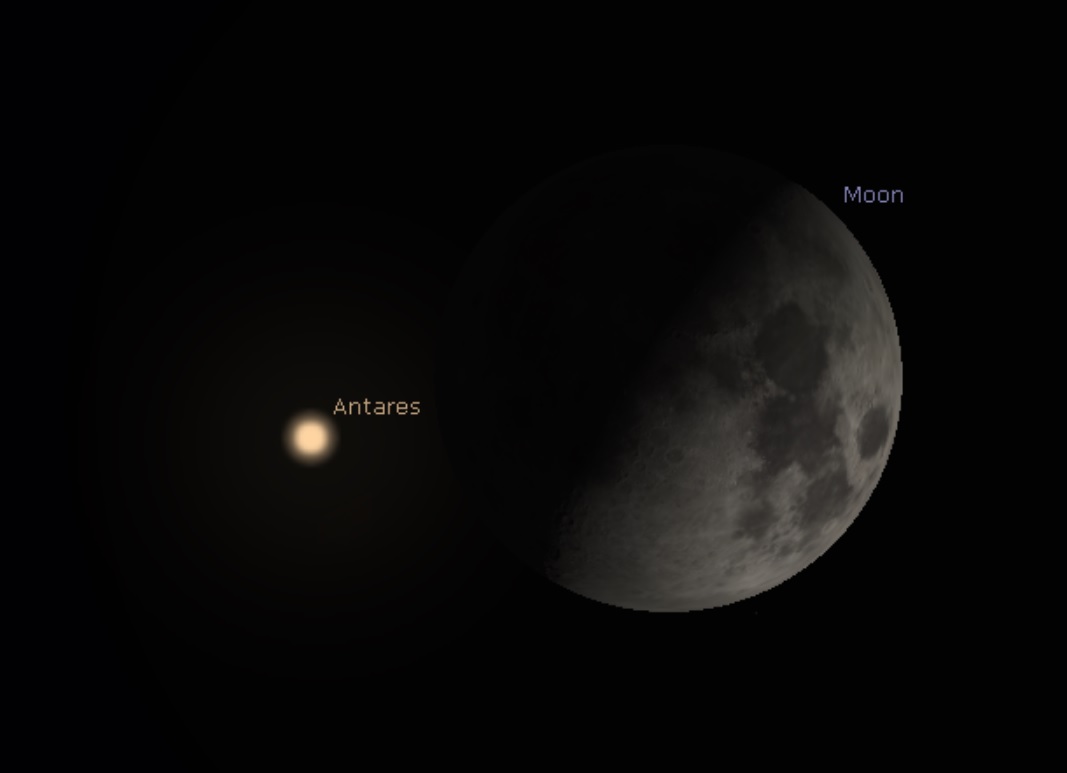Most of North America gets to see the Moon blot out Antares Thursday night.
The long drought of lunar bright star occultations ends this week, as the Moon meets the bright star Antares. This event is one of the best bright star versus the Moon occultations for 2023, and is a harbinger for a series of new occultations of the star once every pass, as the Moon swings through Scorpius the Scorpion every lunar synodic period or 29.5 days.
Despite the cryptic-sounding name, occultations in astronomy are simply when one object passes in front of another, blocking out the light from the more distant object. These can involve planets, asteroids, or as in this week’s case, the Moon and a bright star. In the current epoch, four bright stars lay along the Moon’s celestial path: Spica, Regulus, Aldebaran and Antares (Alpha Scorpii).

Why Occultations Are Important to Astronomy
Lunar occultations can also yield useful scientific data: for example, these events can reveal close double stars seen as they wink out on the limb of the Moon in a step-wise fashion. Grazing events can be especially dramatic, as the star plays hide-and-seek along the lunar limb, revealing peaks and valleys along the Moon’s profile.
Occultations were even used by navigators of yore, to get a fix on their location at sea:
#OnThisDay April 26th, 1614 -English navigator William Baffin observing from the H.M.S. Discovery used an occultation of the bright star Antares by the Moon to get a one time fix of longitude at sea: https://t.co/LYgSvzNLnC #history #astronomy #otd pic.twitter.com/PO1NPFEiHv
— Dave Dickinson (@Astroguyz) April 26, 2019
The August 25th Antares occultation favors most of North America at dusk. It’s still worth checking out the event even if you’re outside the footprint, as the Moon and Antares will make a nice pairing worldwide.

Central conjunction for the event occurs on Friday, August 25th at 2:06 Universal Time (UT), which is currently six hours ahead of U.S. East Coast time. The Moon is 58% illuminated, waxing gibbous during the event, contrasting with +1st magnitude Antares. All that light from Antares took 554 years to get here, only to be blocked out in the last instant.
The International Occultation Timing Association (IOTA) has a list of times for the Antares occultation here.
A Dark Limb Ingress
Occultations during waxing phase are always particularly entrancing, as the dark limb of the Moon leads the way, obscuring the star or planet during ingress. Antares will return to view about an hour later during egress. Observers across northern Mexico and central Florida will be treated to an especially dramatic view, as Antares grazes the southern limb of the Moon. Most of Canada, northern Mexico and the contiguous United States (CONUS) sees the occultation transpire under dark skies, while Baja California and the southwestern United States sees the event in twilight.
And Spica makes two. This is the first of 68 occultations of Antares by the Moon, running out to August 27th, 2028. Spica joins the lunar occultation hit parade in 2024, with 20 events running out to November 17th, 2025.
How to Observe Thursday’s Occultation
Antares is bright enough, that you’ll be able to see the occultation with the naked eye. Of course, binoculars or a telescope will certainly enhance the view. This sort of bright star event also lends itself to making a video recording of the occultation. A simple imaging setup might include a telescope, smartphone and phone adapter clamp.
Don’t miss the ‘great North American lunar occultation!’

